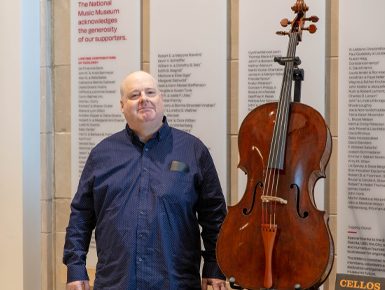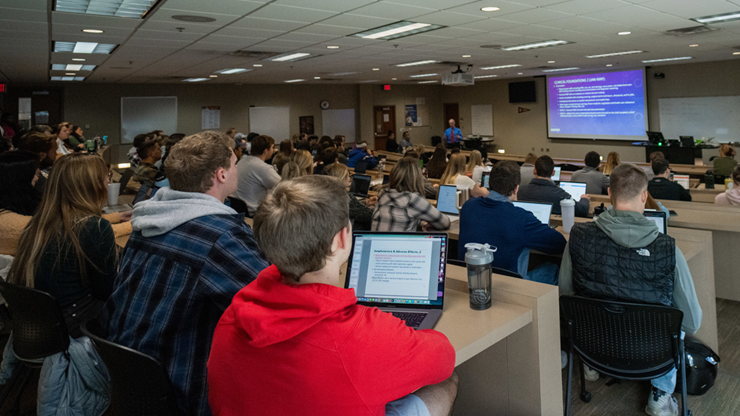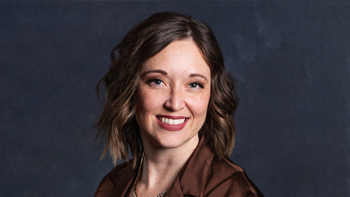One-of-a-Kind USD Music Department, National Music Museum Partnership Enhances Student Experiences

“Our unique relationship with the National Music Museum gives our faculty and students access to resources that no other university in this nation can provide,” said Bruce Kelley, dean of the College of Fine Arts. “No Ivy League, BIG 10 or Southeastern Conference (SEC) university has anything approaching the collection of instruments held by the National Music Museum. Our partnership is truly one of a kind.”
Nestled on USD’s Vermillion campus, the NMM is a world-renowned center for the collection, study, preservation and exhibition of musical instruments, housing over 15,000 instruments, a modern performance hall and several exhibition galleries.
“The NMM is a top cultural institution, with influence and outreach worldwide,” said Dwight Vaught, director of the NMM. “The NMM and USD are really inseparable, with many benefits to both organizations. Many who know USD, know the NMM exists here. Likewise, anyone familiar with the NMM knows its home is USD. The NMM feeds the artistic community as a place for in-depth study and inspiring performances.”
The museum boasts a rich history – a history that’s available to enthusiasts and scholars of all types, including USD’s undergraduate and graduate students.
“Most students can only read about the instruments of the past in their history textbooks and visualize how they might have appeared or sound,” said David Holdhusen, Ph.D., chair of the Department of Music and the Douglas and Susan Tuve Distinguished Professor of Choral Music. “At USD, they can see, and in some cases, touch or hear the actual sounds. This can really help them get a better understanding of how music has evolved.
“The music department’s partnership with the museum is so valuable because of the educational experiences available to our students that are unlike those of the typical college music student,” he continued.
For Grace Goeller, a sophomore cello performance major from Sioux Falls, the partnership means having access to the museum's extensive collection of instruments, resources and knowledgeable staff, which she said benefits her and her classmates in several ways.
"By showcasing instruments that range from hundreds of years old to modern day, students can learn about how music has progressed and adapted into what we know it to be today," said Goeller. "It also helps students to learn about and appreciate music from other cultures around the world. Lastly, the NMM's partnership with the university allows students like me to learn from playing some of the instruments in the museum's collections."
Many of the museum’s musical treasures are for viewing and archival purposes only, but a few, like a 1901 Mason & Hamlin CC concert grand piano, are fully playable, offering a unique experience to guest artists, faculty and students.

“When Ken approached the NMM about being the home for his late father’s collection, he expressed the importance of passing along his father’s passion that the instruments be played and available – we agreed,” said Vaught. “The partnership we have with the USD music department and the College of Fine Arts was a major supporting factor in Ken’s decision to gift the collection to the NMM.”
With the Cancelosi Collection of five cellos and 27 bows, Vaught said the options for playing and study are virtually endless. “The Cancelosi Collection stands apart, fulfilling the vision of both Robert and Ken to ensure future performers have access to hearing and playing exceptional historical instruments,” he said.
Not only do the cellos and bows serve as beautiful tools to be played by fine arts students and faculty, but they also serve as important historical artifacts.
“The cellos, dating from about 1685 to 1777, provide a look into the history of instrument making and craftsmanship in 17th- and 18th-Century Italy,” explained Vaught. “As playable museum objects, the cellos and bows bring the best possible experience to anyone studying music or a scholar doing research because they can see, touch, study, hear and play a piece of musical history.”
"The Cancelosi Collection gives students the opportunity to play instruments of the highest quality,” Holdhusen added. “They can learn how each instrument is unique what they value in a personal instrument. As they play these cellos, they will learn how to bring out the nuances of the music specific to each instrument and, in turn, grow their own performance ability.
“Musical instruments are made to be heard,” Holdhusen continued. “We are so very thankful to have this collection in the museum and that the family has partnered with USD to ensure these instruments are played and not just seen.”
Goeller has had the opportunity to play some of these instruments and said, "it's such a valuable opportunity to have access to these historical instruments and bows and be able to learn from playing them."
"Each instrument and bow is so unique and requires different techniques to play, so I learned something new just by playing them," she continued. "It is rare that instruments like these are available to students, so we are very fortunate to have the partnership with the NMM that allows us to play such beautiful, historical instruments."
Cello performance graduate student Carolina Rodriguez has also played three of the five cellos included in the Cancelosi Collection and said it was a "once in a lifetime opportunity."
"These are incredibly famous cellos and their sound is beyond words," said Rodriguez. "I'm also extremely happy and lucky because I will have my graduation recital at the NMM and will be playing one of the cellos."
After graduation, Rodriguez, who's originally from La Habana, Cuba, hopes to perform as a chamber musician with different ensembles and diverse repertoire. Her experiences in the College of Fine Arts and with the NMM have well developed her professional skills, putting her dream close within reach.
"Having excellent faculty and wonderful guest artists that work with us in masterclasses and perform for us, learning leadership responsibilities as part of different ensembles, and preparing wonderful and challenging repertoire for campus orchestras and chamber music projects have been truly fulfilling and rewarding experiences," said Rodriguez.
"The NMM has also definitely influenced my education," she continued. "The incredible collection of ancient instruments that I've had the privilege to see and learn about is priceless. And of course, the wonderful concerts with excellent guest artists that take place there have been significantly important for my music development."
With the museum’s extensive archives of instruments and related materials, the College of Fine Arts Department of Music offers a Master of Music with specialization in the history of musical instruments degree – the only graduate degree in the history of musical instruments in North America.
“We are the only place in the world that offers this type of degree,” said Holdhusen. “Scholars from around the globe flock here for our collection and to study what we have. As we educate these future leaders in this field, it only ensures that the restoration, study and documentation of these artifacts of music history will continue into the future.”
The history of musical instruments M.M. program is one of several specializations available to graduate students in the Department of Music and is designed to be a small program providing individual attention to a specialized group of scholars. Graduates of the master’s program currently hold top posts in museums in the U.S. and in Europe.



